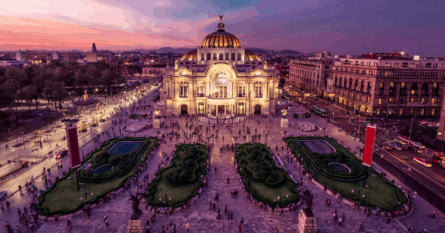From robot guides to a man-made meteor shower, we reveal how the 2020 Tokyo Olympics might be the most futuristic yet.

It’s not just the athletes who will be pulling out all the stops at the 2020 Summer Olympics in Japan – the Tokyo 2020 team is set to wow the crowds with everything from robotic mascots to messages from space. This is one sporting event that’ll be taken to the next level.
The meteor shower
When the giant firework footprints lit up the sky at the 2016 Beijing Summer Olympics, we thought we’d seen it all. But this past event looks average compared to Japan’s plans to switch its firework display for a $4 million dollar meteor shower for it’s Tokyo Olympics.
Japanese start-up company ALE is set to launch a series of microsatellites into orbit in Spring 2020 in Hiroshima that will release hundreds of small particles towards the earth. When these particles hit the atmosphere, they will light up and create an artificial meteor shower.
On a clear day, they should be able to be seen from Tokyo. The ALE team will also be able to choose the color of the shooting stars. Founder and astronomer Dr Lena Okajima said if they are successful, they hope to create a bespoke meteor shower for the opening ceremony of the Olympic Games.
Space ambassadors
The sky is definitely the limit when it comes to supporting the torch bearers at the 2020 Tokyo Olympic and Paralympic Games, with the athletes to receive messages of support from Japanese astronauts Soichi Noguchi and Akihiko Hoshide.
The astronauts, who were both crowned Torch Relay Space Ambassadors, will be sending messages of support from the International Space Station to spur the 10,000 torchbearers on.
But, they won’t be the only ones sending messages from space. In March, the Tokyo 2020 team will launch a satellite into space featuring two anime character robots, who will broadcast messages of support to athletes with the help of a digital bulletin board.
Robots taking over
While the common phrase that robots are going to take over the world has been met with mixed reviews, they are definitely going to take over the Tokyo 2020 games. Not only will you see them on the fields, busy collecting javelins and hammers thrown by the athletes, but they’ll also be hawking drinks and peanuts in the stands and guiding people to their seats.
Sports fans who aren’t able unable to visit the stadium can enjoy a virtual reality experience of the games with the help of the T-TR1 Robot, which will give those the chance to chat in real-time to other fans and athletes.
And as you by now might expect, the mascots for Tokyo 2020 have also received an android makeover. Robots Miraitowa and Someity are Pokemon-style characters that have facial recognition capabilities, so they’ll be able to mirror your image and perfect the ultimate pose for your Instagram post.
Human touch
While Japan’s tech giants are using the games as a way to showcase what they can do, the world’s most futuristic games also feature a human element. Not only are the winners’ medals created from metal taken from old phones donated by the public, but the Games musical anthem was also created with the help of Japan’s sports fans.

The #2020Beat anthem, which is expected to be as infectious as Mexico’s Mexican wave, was created from a combination of everyday noises sent in from people all over Japan to the 2020 Tokyo team. The sounds were combined with digital technology to create a drumbeat with a difference.
In-between events, fans will be encouraged to clap along. If fans can’t reach the stadium, they can also do a selfie video of them performing the #2020Beat and get the chance to have the video played on giant screens found across the sports venues. There are five versions of this stirring anthem and you’re sure to know all of them before the end of the Olympics.
Smooth moves
It should come as no surprise that the country that introduced its first bullet train in time for the 1964 Summer Olympics has pushed the boundaries of transport once more.
Not satisfied with the 320 kilometer-per-hour speed of the trains currently in operation, Japan has given the famed Bullet Trains a makeover with the upcoming introduction of the new N700 Series train, which will be capable of reaching up to 360 kilometers per hour.
When you reach your destination, robot taxis will then be ready to whizz you around the city and if you’re one of the 300,000 people accredited to compete or work at the Games, you’ll be recognized by state-of-the-art facial recognition technology when you arrive at the venue.

Extreme gamification
Electronics giant Intel will be making sure this is the most technologically advanced Olympic competition yet, launching an array of new products for Tokyo 2020.
The company has created virtual reality realms to help athletes visualize the arenas before they get there. It’s also launched a tracking technology that uses an array of 4K video cameras to track an athlete’s performance and uses algorithms to break down the data.
This means that viewers at home will be able to see the speed at which the athletes are racing and any mistakes they might have made. This data will be laid over the top of the live images so you won’t have to wait to listen to the commentators – you’ll be able to analyze the race yourself using these visuals.
The company will also give spectators the chance to compete too. Intel will be running a global eSports gaming competition in parallel with the Olympics in Tokyo, with 20 countries represented. The question is – how long will it be before eSports athletes will be standing on a podium in an Olympic venue and collecting a medal?



